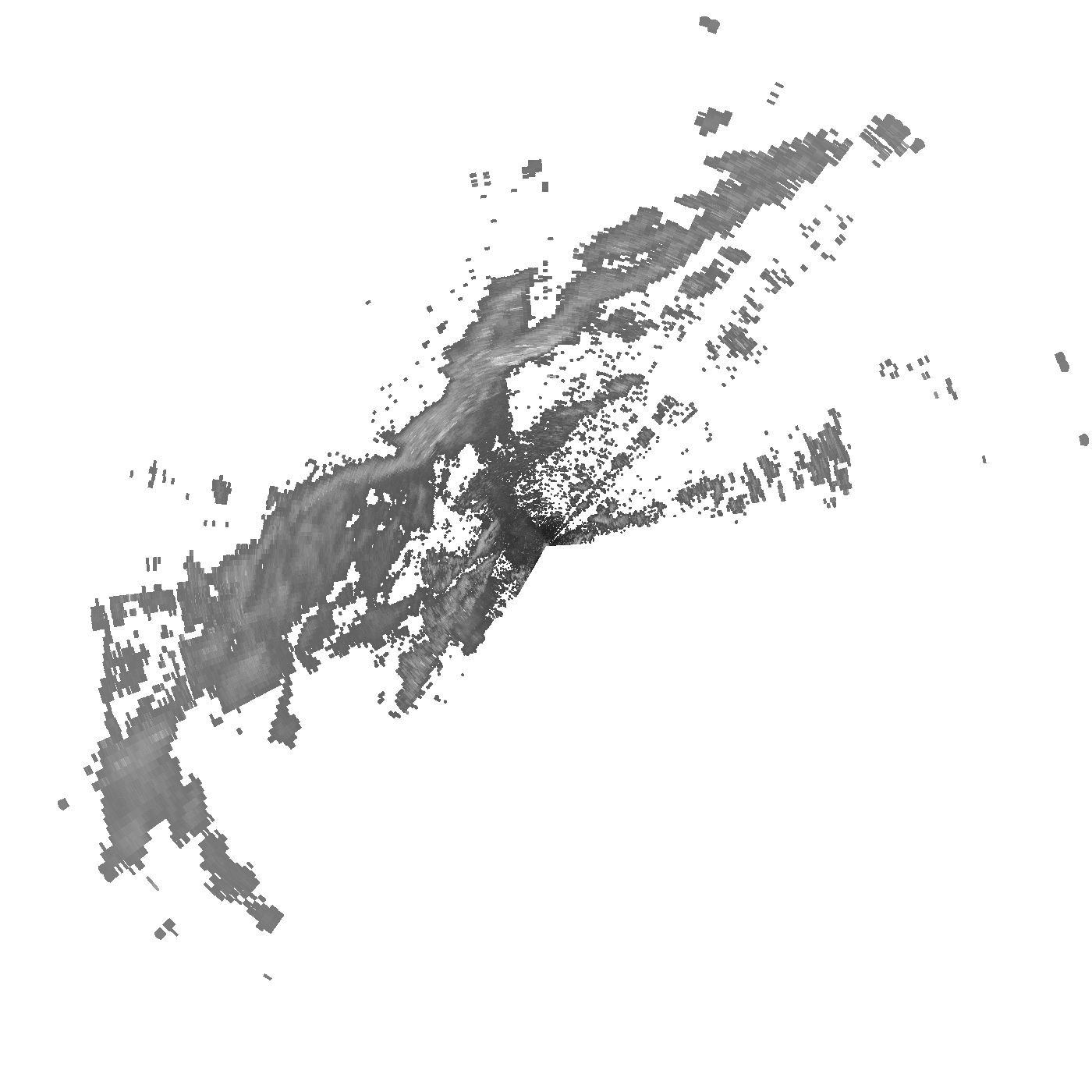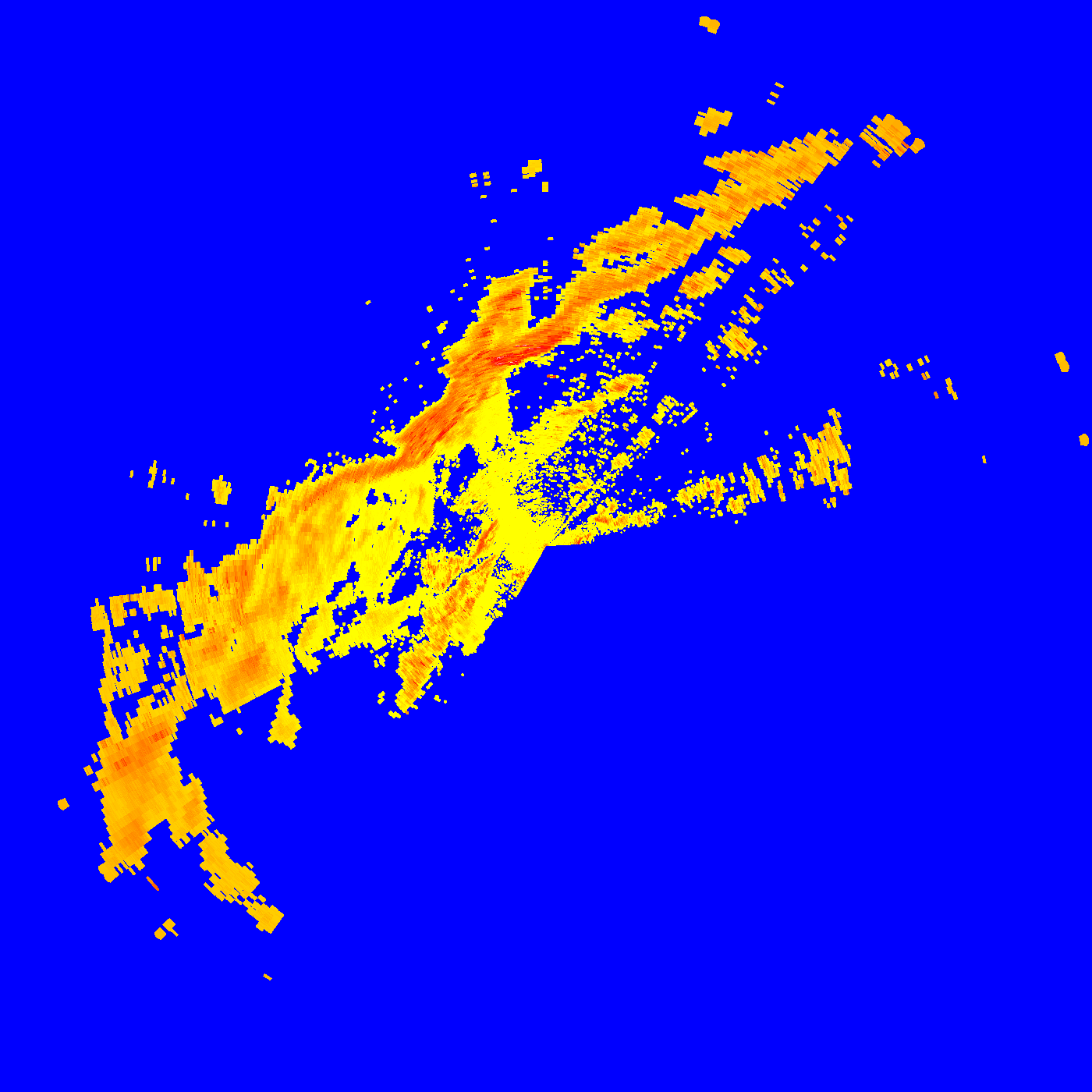wradlib radar data io, visualisation, gridding and gis export
Overview
Within this notebook, we will cover:
Reading radar volume data into xarray based RadarVolume
Examination of RadarVolume and Sweeps
Plotting of sweeps, simple and mapmaking
Gridding and GIS output
Prerequisites
Concepts |
Importance |
Notes |
|---|---|---|
Helpful |
Basic Dataset/DataArray |
|
Helpful |
Basic Plotting |
|
Helpful |
Projections |
|
Helpful |
Raster |
Time to learn: 15 minutes
Imports
import glob
import pathlib
import cartopy
import cartopy.crs as ccrs
import cartopy.feature as cfeature
import matplotlib.pyplot as plt
import numpy as np
import xarray as xr
from matplotlib import ticker as tick
from osgeo import gdal
import wradlib as wrl
/srv/conda/envs/notebook/lib/python3.9/site-packages/requests/__init__.py:102: RequestsDependencyWarning: urllib3 (1.26.8) or chardet (5.2.0)/charset_normalizer (2.0.10) doesn't match a supported version!
warnings.warn("urllib3 ({}) or chardet ({})/charset_normalizer ({}) doesn't match a supported "
Import data into RadarVolume
We have this special case here with Rainbow data where moments are splitted across files. Each file nevertheless consists of all sweeps comprising the volume. We’ll use some special nested ordering to read the files.
fglob = "data/rainbow/meteoswiss/*.vol"
vol = wrl.io.open_rainbow_mfdataset(fglob, combine="by_coords", concat_dim=None)
Examine RadarVolume
The RadarVolume is a shallow class which tries to comply to CfRadial2/WMO-FM301, see WMO-CF_Extensions.
The printout of RadarVolume just lists the dimensions and the associated elevations.
display(vol)
<wradlib.RadarVolume>
Dimension(s): (sweep: 10)
Elevation(s): (0.0, 1.3, 2.9, 4.9, 7.3, 10.2, 13.8, 18.2, 23.5, 30.0)
Root Group
The root-group is essentially an overview over the volume, more or less aligned with CfRadial metadata.
vol.root
<xarray.Dataset>
Dimensions: (sweep: 10)
Coordinates:
time datetime64[ns] 2019-10-21T08:24:09
longitude float64 6.954
altitude float64 735.0
sweep_mode <U20 'azimuth_surveillance'
latitude float64 46.77
Dimensions without coordinates: sweep
Data variables:
volume_number int64 0
platform_type <U5 'fixed'
instrument_type <U5 'radar'
primary_axis <U6 'axis_z'
time_coverage_start <U20 '2019-10-21T08:24:09Z'
time_coverage_end <U20 '2019-10-21T08:29:33Z'
sweep_group_name (sweep) <U7 'sweep_0' 'sweep_1' ... 'sweep_8' 'sweep_9'
sweep_fixed_angle (sweep) float64 0.0 1.3 2.9 4.9 ... 13.8 18.2 23.5 30.0
Attributes:
version: None
title: None
institution: None
references: None
source: None
history: None
comment: im/exported using wradlib
instrument_name: None
fixed_angle: 0.0Sweep Groups
Sweeps are available in a sequence attached to the RadarVolume object.
swp = vol[0]
display(swp)
<xarray.Dataset>
Dimensions: (azimuth: 360, range: 1400)
Coordinates:
* azimuth (azimuth) float64 0.5 1.5 2.5 3.5 ... 356.5 357.5 358.5 359.5
* range (range) float32 25.0 75.0 125.0 ... 6.992e+04 6.998e+04
elevation (azimuth) float64 dask.array<chunksize=(360,), meta=np.ndarray>
time datetime64[ns] 2019-10-21T08:24:09
rtime (azimuth) datetime64[ns] dask.array<chunksize=(360,), meta=np.ndarray>
longitude float64 6.954
latitude float64 46.77
altitude float64 735.0
sweep_mode <U20 'azimuth_surveillance'
Data variables:
DBZH (azimuth, range) float32 dask.array<chunksize=(360, 1400), meta=np.ndarray>
KDP (azimuth, range) float32 dask.array<chunksize=(360, 1400), meta=np.ndarray>
PHIDP (azimuth, range) float32 dask.array<chunksize=(360, 1400), meta=np.ndarray>
RHOHV (azimuth, range) float32 dask.array<chunksize=(360, 1400), meta=np.ndarray>
VRADH (azimuth, range) float32 dask.array<chunksize=(360, 1400), meta=np.ndarray>
WRADH (azimuth, range) float32 dask.array<chunksize=(360, 1400), meta=np.ndarray>
ZDR (azimuth, range) float32 dask.array<chunksize=(360, 1400), meta=np.ndarray>
Attributes:
fixed_angle: 0.0Inspect Scan Strategy
Considering volume files it’s nice to have an overview over the scan strategy. We can choose some reasonable values for the layout.
nrays = 360
nbins = 150
range_res = 1000.0
ranges = np.arange(nbins) * range_res
elevs = vol.root.sweep_fixed_angle.values
sitecoords = (
vol.root.longitude.values.item(),
vol.root.latitude.values.item(),
vol.root.altitude.values.item(),
)
beamwidth = 1.0
ax = wrl.vis.plot_scan_strategy(ranges, elevs, sitecoords)

We can plot it on top of the terrain derived from SRTM DEM.
import os
os.environ["WRADLIB_EARTHDATA_BEARER_TOKEN"] = ""
os.environ["WRADLIB_DATA"] = "data/wradlib-data"
ax = wrl.vis.plot_scan_strategy(ranges, elevs, sitecoords, terrain=True)
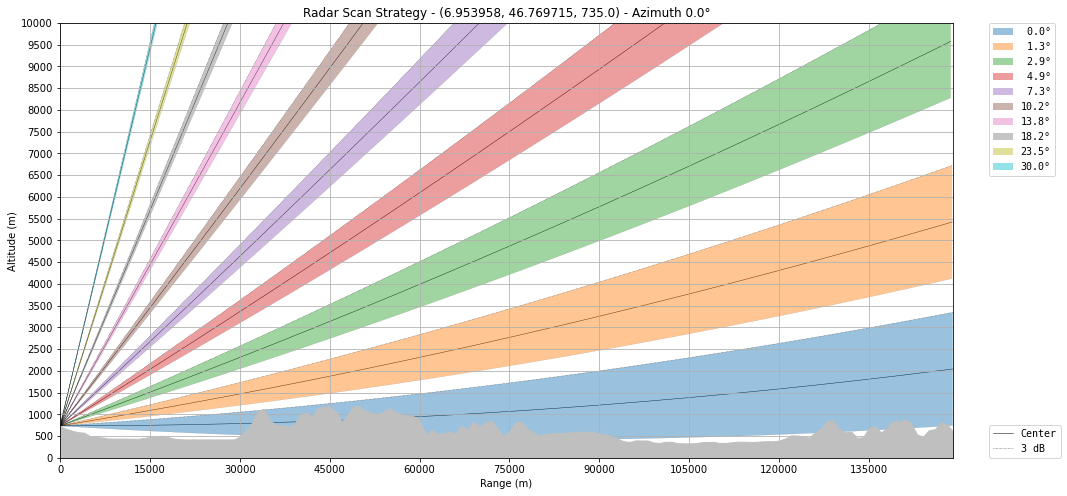
Let’s make the earth go round…
ax = wrl.vis.plot_scan_strategy(
ranges, elevs, sitecoords, cg=True, terrain=True, az=180
)
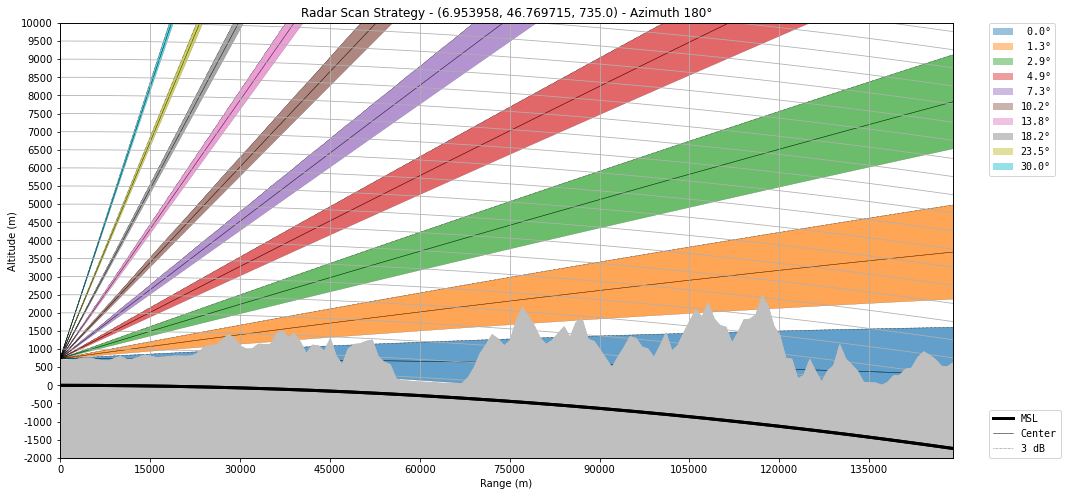
Plotting Radar Data
Time vs. Azimuth
fig = plt.figure(figsize=(10, 5))
ax1 = fig.add_subplot(111)
swp.azimuth.sortby("rtime").plot(x="rtime", marker=".")
[<matplotlib.lines.Line2D at 0x7fa684ced490>]
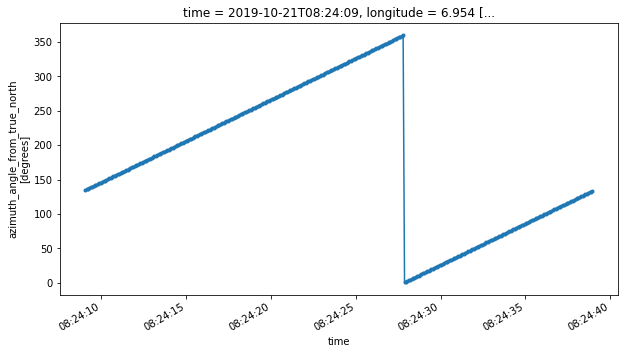
Range vs. Azimuth/Time
fig = plt.figure(figsize=(10, 5))
ax1 = fig.add_subplot(121)
swp.DBZH.plot(cmap="turbo", ax=ax1)
ax1.set_title(f"{swp.time.values.astype('M8[s]')}")
ax2 = fig.add_subplot(122)
swp.DBZH.sortby("rtime").plot(y="rtime", cmap="turbo", ax=ax2)
ax2.set_title(f"{swp.time.values.astype('M8[s]')}")
plt.tight_layout()
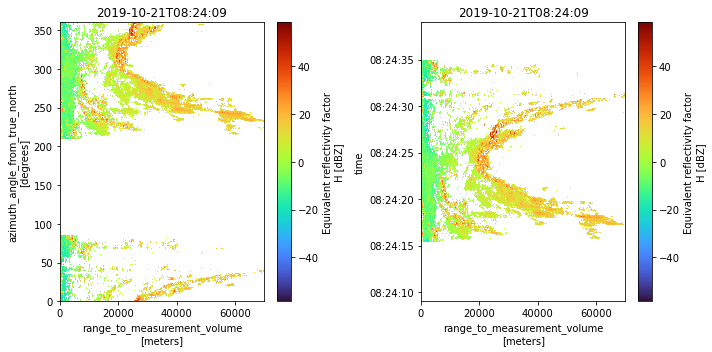
Georeferenced as Plan Position Indicator
fig = plt.figure(figsize=(10, 10))
ax1 = fig.add_subplot(111)
swp.DBZH.pipe(wrl.georef.georeference_dataset).plot(
x="x", y="y", ax=ax1, cmap="turbo", cbar_kwargs=dict(shrink=0.8)
)
ax1.plot(0, 0, "rx", markersize=12)
ax1.set_title(f"{swp.time.values.astype('M8[s]')}")
ax1.grid()
ax1.set_aspect("equal")

Basic MapMaking with cartopy
The data will be georeferenced as Azimuthal Equidistant Projection centered at the radar. For the map projection we will use Mercator.
map_trans = ccrs.AzimuthalEquidistant(
central_latitude=swp.latitude.values, central_longitude=swp.longitude.values
)
map_proj = ccrs.Mercator(central_longitude=swp.longitude.values)
def plot_borders(ax):
borders = cfeature.NaturalEarthFeature(
category="cultural", name="admin_0_countries", scale="10m", facecolor="none"
)
ax.add_feature(borders, edgecolor="black", lw=2, zorder=4)
fig = plt.figure(figsize=(10, 8))
ax = fig.add_subplot(111, projection=map_proj)
cbar_kwargs = dict(shrink=0.7, pad=0.075)
pm = swp.DBZH.pipe(wrl.georef.georeference_dataset).plot(
ax=ax, x="x", y="y", cbar_kwargs=cbar_kwargs, cmap="turbo", transform=map_trans
)
plot_borders(ax)
ax.gridlines(draw_labels=True)
ax.plot(
swp.longitude.values, swp.latitude.values, transform=map_trans, marker="*", c="r"
)
ax.set_title(f"{swp.time.values.astype('M8[s]')}")
ax.set_xlim(-15e4, 45e4)
ax.set_ylim(565e4, 610e4)
plt.tight_layout()
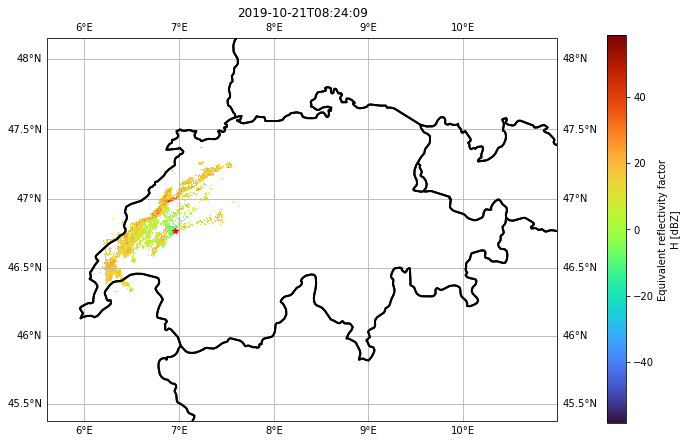
Plot on curvelinear grid
For Xarray DataArrays wradlib uses a so-called accessor (wradlib). To plot on curvelinear grids projection has to be set to cg, which uses the matplotlib AXISARTIS namespace.
fig = plt.figure(figsize=(10, 8))
pm = swp.DBZH.pipe(wrl.georef.georeference_dataset).wradlib.plot(
proj="cg", fig=fig, cmap="turbo"
)
ax = plt.gca()
# apply eye-candy
caax = ax.parasites[0]
paax = ax.parasites[1]
ax.parasites[1].set_aspect("equal")
t = plt.title(f"{vol[0].time.values.astype('M8[s]')}", y=1.05)
cbar = plt.colorbar(pm, pad=0.075, ax=paax)
caax.set_xlabel("x_range [m]")
caax.set_ylabel("y_range [m]")
plt.text(1.0, 1.05, "azimuth", transform=caax.transAxes, va="bottom", ha="right")
cbar.set_label("reflectivity [dBZ]")
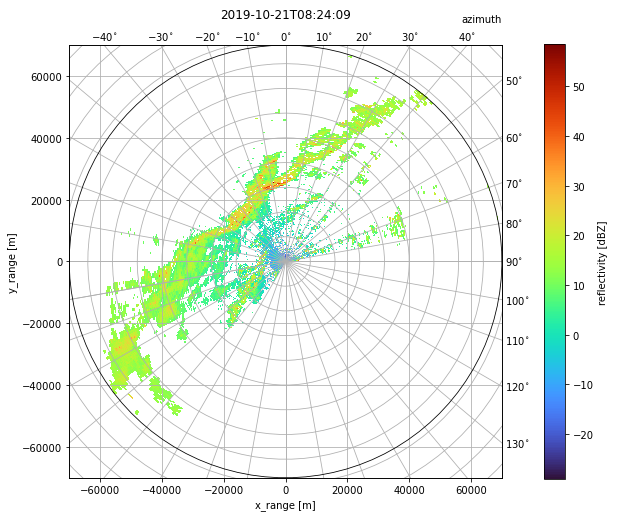
ODIM_H5 format export and import
Import from ODIM_H5
vol2 = wrl.io.open_odim_dataset("test_odim_vol.h5")
display(vol2)
<wradlib.RadarVolume>
Dimension(s): (sweep: 10)
Elevation(s): (0.0, 1.3, 2.9, 4.9, 7.3, 10.2, 13.8, 18.2, 23.5, 30.0)
display(vol2[0])
<xarray.Dataset>
Dimensions: (azimuth: 360, range: 1400)
Coordinates:
* azimuth (azimuth) float64 0.5 1.5 2.5 3.5 ... 356.5 357.5 358.5 359.5
elevation (azimuth) float64 0.0 0.0 0.0 0.0 0.0 ... 0.0 0.0 0.0 0.0 0.0
rtime (azimuth) datetime64[ns] 2019-10-21T08:24:27.875000064 ... 20...
* range (range) float32 25.0 75.0 125.0 ... 6.992e+04 6.998e+04
time datetime64[ns] 2019-10-21T08:24:09
sweep_mode <U20 'azimuth_surveillance'
longitude float64 6.954
latitude float64 46.77
altitude float64 735.0
Data variables:
DBZH (azimuth, range) float32 ...
KDP (azimuth, range) float32 ...
PHIDP (azimuth, range) float32 ...
RHOHV (azimuth, range) float32 ...
VRADH (azimuth, range) float32 ...
WRADH (azimuth, range) float32 ...
ZDR (azimuth, range) float32 ...
Attributes:
fixed_angle: 0.0Import with xarray backends
We can facilitate the xarray backend’s which wradlib provides for the different readers. The xarray backends are capable of loading data into a single Dataset for now. So we need to give some information here too.
Open single files
The simplest case can only open one file and one group a time!
ds = xr.open_dataset("test_odim_vol.h5", engine="odim", group="dataset1")
display(ds)
<xarray.Dataset>
Dimensions: (azimuth: 360, range: 1400)
Coordinates:
* azimuth (azimuth) float64 0.5 1.5 2.5 3.5 ... 356.5 357.5 358.5 359.5
elevation (azimuth) float64 0.0 0.0 0.0 0.0 0.0 ... 0.0 0.0 0.0 0.0 0.0
rtime (azimuth) datetime64[ns] 2019-10-21T08:24:27.875000064 ... 20...
* range (range) float32 25.0 75.0 125.0 ... 6.992e+04 6.998e+04
time datetime64[ns] 2019-10-21T08:24:09
sweep_mode <U20 'azimuth_surveillance'
longitude float64 6.954
latitude float64 46.77
altitude float64 735.0
Data variables:
DBZH (azimuth, range) float32 ...
KDP (azimuth, range) float32 ...
PHIDP (azimuth, range) float32 ...
RHOHV (azimuth, range) float32 ...
VRADH (azimuth, range) float32 ...
WRADH (azimuth, range) float32 ...
ZDR (azimuth, range) float32 ...
Attributes:
fixed_angle: 0.0Open multiple files
Here we just specify the group, which in case of rainbow files is given by the group number.
ds = xr.open_mfdataset(fglob, engine="rainbow", group=0, combine="by_coords")
display(ds)
<xarray.Dataset>
Dimensions: (azimuth: 360, range: 1400)
Coordinates:
* azimuth (azimuth) float64 0.5 1.5 2.5 3.5 ... 356.5 357.5 358.5 359.5
* range (range) float32 25.0 75.0 125.0 ... 6.992e+04 6.998e+04
elevation (azimuth) float64 dask.array<chunksize=(360,), meta=np.ndarray>
time datetime64[ns] 2019-10-21T08:24:09
rtime (azimuth) datetime64[ns] dask.array<chunksize=(360,), meta=np.ndarray>
longitude float64 6.954
latitude float64 46.77
altitude float64 735.0
sweep_mode <U20 'azimuth_surveillance'
Data variables:
DBZH (azimuth, range) float32 dask.array<chunksize=(360, 1400), meta=np.ndarray>
KDP (azimuth, range) float32 dask.array<chunksize=(360, 1400), meta=np.ndarray>
PHIDP (azimuth, range) float32 dask.array<chunksize=(360, 1400), meta=np.ndarray>
RHOHV (azimuth, range) float32 dask.array<chunksize=(360, 1400), meta=np.ndarray>
VRADH (azimuth, range) float32 dask.array<chunksize=(360, 1400), meta=np.ndarray>
WRADH (azimuth, range) float32 dask.array<chunksize=(360, 1400), meta=np.ndarray>
ZDR (azimuth, range) float32 dask.array<chunksize=(360, 1400), meta=np.ndarray>
Attributes:
fixed_angle: 0.0Gridding and Export to GIS formats
get coordinates from source Dataset with given projection
calculate target coordinates
grid using wradlib interpolator
export to single band geotiff
use GDAL CLI tools to convert to grayscaled/paletted PNG
def get_target_grid(ds, nb_pixels):
xgrid = np.linspace(ds.x.min(), ds.x.max(), nb_pixels, dtype=np.float32)
ygrid = np.linspace(ds.y.min(), ds.y.max(), nb_pixels, dtype=np.float32)
grid_xy_raw = np.meshgrid(xgrid, ygrid)
grid_xy_grid = np.dstack((grid_xy_raw[0], grid_xy_raw[1]))
return xgrid, ygrid, grid_xy_grid
def get_target_coordinates(grid):
grid_xy = np.stack((grid[..., 0].ravel(), grid[..., 1].ravel()), axis=-1)
return grid_xy
def get_source_coordinates(ds):
xy = np.stack((ds.x.values.ravel(), ds.y.values.ravel()), axis=-1)
return xy
def coordinates(da, proj, res=100):
# georeference single sweep
da = da.pipe(wrl.georef.georeference_dataset, proj=proj)
# get source coordinates
src = get_source_coordinates(da)
# create target grid
xgrid, ygrid, trg = get_target_grid(da, res)
return src, trg
def moment_to_gdal(da, trg_grid, driver, ext, path="", proj=None):
# use wgs84 pseudo mercator if no projection is given
if proj is None:
proj = wrl.georef.epsg_to_osr(3857)
t = da.time.values.astype("M8[s]").astype("O")
outfilename = f"gridded_{da.name}_{t:%Y%m%d}_{t:%H%M%S}"
outfilename = os.path.join(path, outfilename)
f = pathlib.Path(outfilename)
f.unlink(missing_ok=True)
res = ip_near(da.values.ravel(), maxdist=1000).reshape(
(len(trg_grid[0]), len(trg_grid[1]))
)
data, xy = wrl.georef.set_raster_origin(res, trg_grid, "upper")
ds = wrl.georef.create_raster_dataset(data, xy, projection=proj)
wrl.io.write_raster_dataset(outfilename + ext, ds, driver)
Coordinates
%%time
epsg_code = 2056
proj = wrl.georef.epsg_to_osr(epsg_code)
src, trg = coordinates(ds, proj, res=1400)
CPU times: user 865 ms, sys: 56.1 ms, total: 921 ms
Wall time: 920 ms
Interpolator
%%time
ip_near = wrl.ipol.Nearest(src, trg.reshape(-1, trg.shape[-1]), remove_missing=7)
CPU times: user 2.7 s, sys: 32.1 ms, total: 2.73 s
Wall time: 2.73 s
Gridding and Export
%%time
moment_to_gdal(ds.DBZH, trg, "GTiff", ".tif", proj=proj)
CPU times: user 155 ms, sys: 23.5 ms, total: 178 ms
Wall time: 178 ms
GDAL info on created GeoTiff
!gdalinfo gridded_DBZH_20191021_082409.tif
Driver: GTiff/GeoTIFF
Files: gridded_DBZH_20191021_082409.tif
Size is 1400, 1400
Coordinate System is:
PROJCRS["CH1903+ / LV95",
BASEGEOGCRS["CH1903+",
DATUM["CH1903+",
ELLIPSOID["Bessel 1841",6377397.155,299.1528128,
LENGTHUNIT["metre",1]]],
PRIMEM["Greenwich",0,
ANGLEUNIT["degree",0.0174532925199433]],
ID["EPSG",4150]],
CONVERSION["Swiss Oblique Mercator 1995",
METHOD["Hotine Oblique Mercator (variant B)",
ID["EPSG",9815]],
PARAMETER["Latitude of projection centre",46.9524055555556,
ANGLEUNIT["degree",0.0174532925199433],
ID["EPSG",8811]],
PARAMETER["Longitude of projection centre",7.43958333333333,
ANGLEUNIT["degree",0.0174532925199433],
ID["EPSG",8812]],
PARAMETER["Azimuth of initial line",90,
ANGLEUNIT["degree",0.0174532925199433],
ID["EPSG",8813]],
PARAMETER["Angle from Rectified to Skew Grid",90,
ANGLEUNIT["degree",0.0174532925199433],
ID["EPSG",8814]],
PARAMETER["Scale factor on initial line",1,
SCALEUNIT["unity",1],
ID["EPSG",8815]],
PARAMETER["Easting at projection centre",2600000,
LENGTHUNIT["metre",1],
ID["EPSG",8816]],
PARAMETER["Northing at projection centre",1200000,
LENGTHUNIT["metre",1],
ID["EPSG",8817]]],
CS[Cartesian,2],
AXIS["(E)",east,
ORDER[1],
LENGTHUNIT["metre",1]],
AXIS["(N)",north,
ORDER[2],
LENGTHUNIT["metre",1]],
USAGE[
SCOPE["Cadastre, engineering survey, topographic mapping (large and medium scale)."],
AREA["Liechtenstein; Switzerland."],
BBOX[45.82,5.96,47.81,10.49]],
ID["EPSG",2056]]
Data axis to CRS axis mapping: 1,2
Origin = (2492961.000000000000000,1249970.687500000000000)
Pixel Size = (100.000000000000000,-100.125000000000000)
Metadata:
AREA_OR_POINT=Area
Image Structure Metadata:
INTERLEAVE=BAND
Corner Coordinates:
Upper Left ( 2492961.000, 1249970.688) ( 6d 1'17.65"E, 47d23'35.61"N)
Lower Left ( 2492961.000, 1109795.688) ( 6d 3'15.75"E, 46d 7'56.52"N)
Upper Right ( 2632961.000, 1249970.688) ( 7d52'34.61"E, 47d24' 3.98"N)
Lower Right ( 2632961.000, 1109795.688) ( 7d51'58.24"E, 46d 8'24.24"N)
Center ( 2562961.000, 1179883.188) ( 6d57'16.56"E, 46d46'13.43"N)
Band 1 Block=1400x1 Type=Float32, ColorInterp=Gray
NoData Value=-9999
Translate exported GeoTiff to grayscale PNG
!gdal_translate -of PNG -ot Byte -scale -30. 60. 0 255 gridded_DBZH_20191021_082409.tif grayscale.png
Input file size is 1400, 1400
Warning 1: for band 1, nodata value has been clamped to 0, the original value being out of range.
0
...10...20...30...40...50...60...70...80...90...100 - done.
Apply colortable to PNG
with open("colors.txt", "w") as f:
f.write("0 blue\n")
f.write("50 yellow\n")
f.write("100 yellow\n")
f.write("150 orange\n")
f.write("200 red\n")
f.write("250 white\n")
Display exported PNG’s
!gdaldem color-relief grayscale.png colors.txt paletted.png
0...
10...20...30...40...50
...60...70...80...90...100 - done.
Import with Xarray, rasterio backend
with xr.open_dataset("gridded_DBZH_20191021_082409.tif", engine="rasterio") as ds_grd:
display(ds_grd)
ds_grd.band_data.plot(cmap="turbo")
/srv/conda/envs/notebook/lib/python3.9/site-packages/pyproj/crs/_cf1x8.py:511: UserWarning: angle from rectified to skew grid parameter lost in conversion to CF
warnings.warn(
<xarray.Dataset>
Dimensions: (band: 1, x: 1400, y: 1400)
Coordinates:
* band (band) int64 1
* x (x) float64 2.493e+06 2.493e+06 ... 2.633e+06 2.633e+06
* y (y) float64 1.25e+06 1.25e+06 1.25e+06 ... 1.11e+06 1.11e+06
spatial_ref int64 0
Data variables:
band_data (band, y, x) float32 ...

